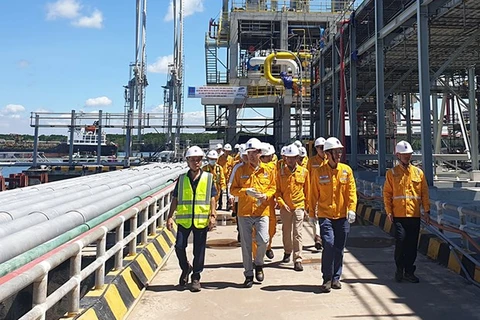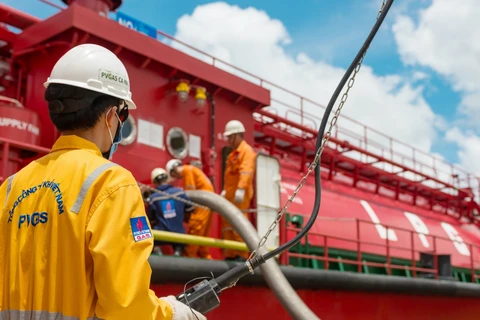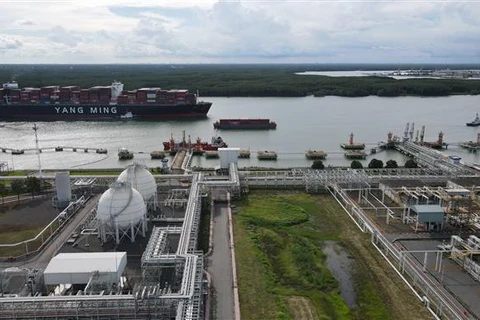 The first liquefied natural gas (LNG) terminal in Vietnam is invested by PV Gas. (Photo: zingnews.vn)
The first liquefied natural gas (LNG) terminal in Vietnam is invested by PV Gas. (Photo: zingnews.vn) Hanoi, (VNA) – The first liquefied natural gas (LNG) terminal in Vietnam, located at Cai Mep Industrial Park in Tan Phuoc ward, Phu My township, southern Ba Ria-Vung Tau province, is now ready for the first batch of LNG.
PetroVietnam Gas Joint Stock Corporation (PV Gas) has invested 285 million USD in the project, which has a capacity of storing 1 million tonnes of LNG, equivalent to about 180,000 cubic metres.
It is also capable of accommodating LNG ships of up to 85,000 tonnes.
The first batch of LNG from abroad arrived at Thi Vai early July 10, with nearly 70,000 tonnes of LNG transported by the Greek-flagged Maran Gas Achilles from Bontang port of Indonesia.
The Thi Vai LNG facility alone will supply about 1.4 billion cubic metres of gas to the Nhon Trach 3 and 4 power plants, industrial customers and make up for part of the gas shortage in the country after 2022.
According to PV Gas’s plan, the Thi Vai LNG terminal will be an important link in the supply of recycled gas to gas consumers. Along with investment in Son My LNG import terminal, which will have a total annual capacity of up to 10 million tonnes of LNG, PV Gas’s LNG infrastructure will meet the future energy needs of the southern region.
The construction of the Thi Vai LNG is among steps taken by PV Gas in preparation for the green transition process.
The corporation is the first in Vietnam to build an LNG storage complex comprising of tanks, pipes, berths, pump station and areas for recycling gas.
Work on the Thi Vai LNG terminal started in October 2019. The construction had faced many difficulties, especially during the period of COVID-19 in 2020 and 2021.
PV Gas had a plan to expand the warehouse’s capacity to 3-6 million tonnes per year.
 he construction of the Thi Vai LNG is among steps taken by PV Gas in preparation for the green transition process (Photo: zingnews.vn)
he construction of the Thi Vai LNG is among steps taken by PV Gas in preparation for the green transition process (Photo: zingnews.vn) In the Vietnamese market, PV Gas is the first and only qualified company granted the certificate of eligibility for LNG import and export.
Under the Power Development Plan for the period 2021-2030, with a vision to 2050 (PDP 8), LNG-fueled power will account for over 14.9% of the total national installed power source capacity by 2030, which is expected to help ensure a sufficient, stable, and safe supply for the national power system.
The PDP 8 also determines that by 2030, there will be 13 new LNG power plants with total capacity of 22,400 MW, and two more with 3,000 MW each will come online by 2035 to balance the demand within three regions: North, North Central Coast, and South./.























